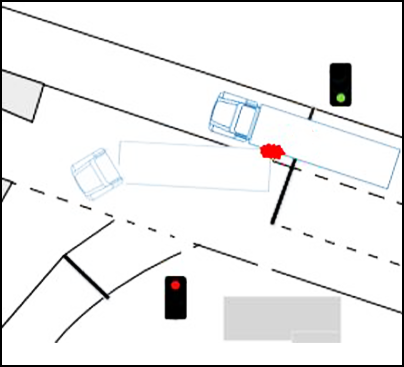-
What happened?
A heavy goods vehicle (HGV) loaded with fuel was in the right-hand lane approaching a traffic light.
In the left-hand lane was a car transporter. Both were travelling within speed limit.
The car transporter was ahead of the HGV and turned left at the lights.
The transporter’s rear-end hit the trailer’s tank, puncturing compartments 3 and 4 resulting into roughly 10,000 litres of fuel spilling onto the road.
The driver applied emergency safeguards.
Nobody was injured in the incident.

-
Why did it happen?
The driver was driving a safe speed but did not recognise the hazard of the transporter.
Lack of automated system in the haulier to warn drivers of critical locations/blackspots.
The journey management process did not include any information on the newly constructed junction/traffic lights.
The defensive driving training (DDT) provided to drivers did not cover the risk of heavy vehicles making wider turns (and likely interfering on neighbouring lanes).
The driver did not apply emergency safeguards in the correct order (speed and distance, isolate battery, move away from the incident etc).
Hazard reporting wasn’t proactively done by the drivers to identify unsafe spots.

-
What did they learn?
Hauliers should note any changes to the roads and traffic and pass the details to management (to be included in the regular reviews of the journey management plans).
Drivers should be proactive and report incidents and near misses.
Implement incident data systems to provide reports of near misses to identify unsafe blackspots.
Consider installing automated warning systems on pre-identified black-spots or critical locations in HGVs.
Defensive driving programmes should cover dynamic traffic situations (e.g. heavy vehicles making wider turns) in more detail.
Drivers should follow legislation and safety instructions during emergency response in the correct order (e.g. stopping the engine and isolating battery, avoiding sources of ignition i.e. from mobile phones, moving away from the vicinity of the accident and advising other persons to move away).
Review design specifications of the HGVs with manufacturers to improve robustness against damage during collisions.

-
Ask yourself or your crew
Have you ever been in a traffic situation like this? What happened?
What is your emergency response protocol in the case of an accident?
Do you report near misses/potential hazards in your role? If not, why not?
How are your journey management plans (JMPs) completed with relevant information for individual journeys?
What training do you have for your job? What additional training you feel you might need (if any)?
What information on design requirements do you bring to negotiations with HGV manufacturers?

Add to homescreen
Content name
Select existing category:
Content name
New collection
Edit collection
What happened?
A heavy goods vehicle (HGV) loaded with fuel was in the right-hand lane approaching a traffic light.
In the left-hand lane was a car transporter. Both were travelling within speed limit.
The car transporter was ahead of the HGV and turned left at the lights.
The transporter’s rear-end hit the trailer’s tank, puncturing compartments 3 and 4 resulting into roughly 10,000 litres of fuel spilling onto the road.
The driver applied emergency safeguards.
Nobody was injured in the incident.

Why did it happen?
The driver was driving a safe speed but did not recognise the hazard of the transporter.
Lack of automated system in the haulier to warn drivers of critical locations/blackspots.
The journey management process did not include any information on the newly constructed junction/traffic lights.
The defensive driving training (DDT) provided to drivers did not cover the risk of heavy vehicles making wider turns (and likely interfering on neighbouring lanes).
The driver did not apply emergency safeguards in the correct order (speed and distance, isolate battery, move away from the incident etc).
Hazard reporting wasn’t proactively done by the drivers to identify unsafe spots.
What did they learn?
Hauliers should note any changes to the roads and traffic and pass the details to management (to be included in the regular reviews of the journey management plans).
Drivers should be proactive and report incidents and near misses.
Implement incident data systems to provide reports of near misses to identify unsafe blackspots.
Consider installing automated warning systems on pre-identified black-spots or critical locations in HGVs.
Defensive driving programmes should cover dynamic traffic situations (e.g. heavy vehicles making wider turns) in more detail.
Drivers should follow legislation and safety instructions during emergency response in the correct order (e.g. stopping the engine and isolating battery, avoiding sources of ignition i.e. from mobile phones, moving away from the vicinity of the accident and advising other persons to move away).
Review design specifications of the HGVs with manufacturers to improve robustness against damage during collisions.
Ask yourself or your crew
Have you ever been in a traffic situation like this? What happened?
What is your emergency response protocol in the case of an accident?
Do you report near misses/potential hazards in your role? If not, why not?
How are your journey management plans (JMPs) completed with relevant information for individual journeys?
What training do you have for your job? What additional training you feel you might need (if any)?
What information on design requirements do you bring to negotiations with HGV manufacturers?
A heavy goods vehicle (HGV) was in the right-hand lane at a traffic light. It was punctured by a car transporter who was turning left at the lights, spilling 10,000 litres of fuel. No one was injured.












